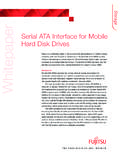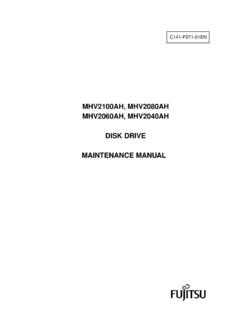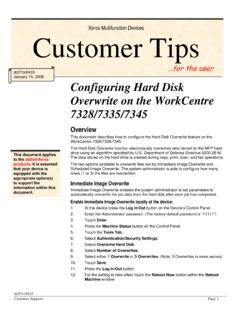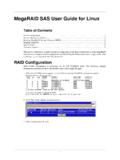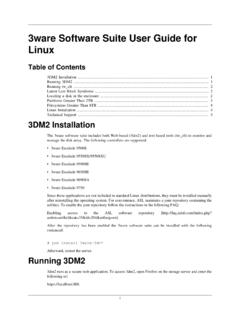Transcription of Alain Knaff ([email protected]) ABSTRACT - Hermann Seib
1 The floppy user guideMichael Haardt Knaff C. Niemi document1is intended for people interested in details about floppy drives, the in-terface bus, data recording, logical structure of data on the floppy and more. The connec-tion to Linux is made where applicable to show how floppies from other computers canbe accessed or how and why it is possible to put more data on a floppy. Since they usethe same interface, there is also a small section about floppy tape 11th, unmodified version of this document may be distributed without charge, both as roff source or as formatted or Floppy drive sizesInside the case is the floppy disk , a round plastic foil coated with a material containing metal oxide, whichcan be magnetised to store information.
2 The case has multiple openings. The bigger hole in the middleallows the drive motor to spin the floppy floppy drives use a DC-motor with a variable resistor to adjust the speed. They often have astroboscope ring on their bottom for that purpose. Modern drives hav e brushless motors. The big disk onthe bottom contains permanent magnets and is controlled by an SIL-IC with a heat pipe and connections tocoils under the disk . This unit is controlled with a crystal or ceramics resonator. If you want to change thedrive speed, adjusting the variable resistor works for older drives, but not for newer ones.
3 On those, youwill need to change the crystal. The speed may off by at most 2%.The longish hole is used for the drive read/write head to touch the disk . The smallest hole in the case is fordetecting the index hole. An LED/optical element gives a signal when the index hole appears. The write-protect notches are sensed using micro are one sided and two sided floppy disk drives, depending on if they only have a head on bottom oralso on top. Floppies are available as both one or two sided, but here one sided only means that only side 0is verified by the manufacturer.
4 You may use side 1 at your own risk. At today s prices that should not bean issue any more, transporting floppy drives, the read/write heads should be protected from touching each other with apiece of cardboard like shown below. Usually those come with the drive when you buy it, but if you didn tget one, then you can copy the given pictures on thin cardboard and cut them out. If nothing else, youshould at least insert an old floppy in the drive. The drive door should be locked. Make sure to remove thecardboard from the drive before switching it on 8" drivesThis is the oldest format, they are just called floppy disks.
5 It is rarely used these days. 8" floppies rotatewith a speed of 360 RPM. It is common for these drives to need +24V, and +5V, as well as110/230V, the latter being used for synchronisation. To switch between 50 and 60 Hz, you have to turn thewheel which drives the belt around, to change the used radius. Many drives support both hard and softsectored floppies, selectable with a jumper. For certain drives, you have to install an upgrade kit for hardsectored 51 4" drivesThis format appeared under the name mini floppy disks.
6 They were intended as replacement for 8" disks,so you can replace an 8" soft sectored drive with a 51 4" drive (if you only want to continue running themachine). The other way round, you can connect soft sectored 8" drives to floppy disk controllers whichare intended for 51 4" floppies. DD drives rotate with a speed of 300 RPM, HD drives at 360 RPM. If a HDdrive accesses a DD floppy, it either switches to 300 RPM (dual speed drive) or the controller works with adata rate of 300 kBit/s instead of 250 kBit/s, like most PCs 3" drivesAmstrad used 3" floppies in the CPC and PCW series.
7 Nobody else did, so this format has floppy case was more robust than the 31 2" case is, which caused it to be about two times as thick. Alsosimilar to 31 2" floppies, they hav e a slider which protects the floppy disk and only opens inside the drive tolet the read/write head touch the 31 2" drivesThis is the standard format these days, usually called micro floppy disks. The floppies rotate with with 300 RPM. The Macintosh DD floppies make an exception as they hav e a variable speed, rotating from 300 fact 31 2" floppies should be called 90-mm-floppies, as they were introduced as such in Japan, wherepeople use metrical units, but 31 2" are almost 90 mm and everybody knows them by this name these the following standards describing them show the true name.
8 ISO type 301 = 90 mm, DDISO type 302 = 90 mm, HDISO type 303 = 90 mm, EDThe 31 2" disks have no index hole but a small square Floppy geometryMost floppies which are in use today store data on tracks which are organized as concentric circles. Thosetracks are further divided into sectors (see below). Tracks are accessed by moving the disk drive are counted beginning with 0, with track 0 always being the most outside track on side 0. Trackswhich are vertically over each other ( track 0 and the track which is located right under track 0 on theother side) are called a cylinder.
9 Tracks may be counted either using flip sides, that is cylinder 0 containingtrack 0 and track 1, or up and over with cylinder 0 containing track 0 and track 159 (for 80 cylinderformats). 8" drives usually support 77 cylinders. 51 4" drives usually support either 35 (old and rare), 40, 77(also old and rare) or 80 cylinders. 31 2" drives usually support 80 cylinders. 3" drives are available with 40or 80 are manufacturer specifications. Experience has shown that many drives support a little once if a drive does will probably not damage it (no warranty on that though).
10 But if the drivemakes odd mechanical noises or you get errors, then stop immediately or the drive may get physicallydamaged. A track on a 31 2" disk is about mm wide, so the mechanics has to be very exact and it isquite a matter of fact, the tracks of a cylinder are not exactly over each other, but spatially interleaved. Forthat reason you can not read a floppy which was written in a dual head drive by flipping it in a single headdrive (ev en if you could reverse the spin direction).

